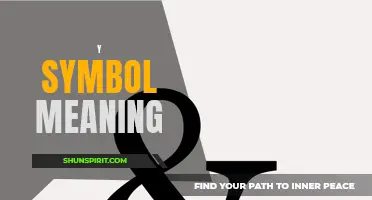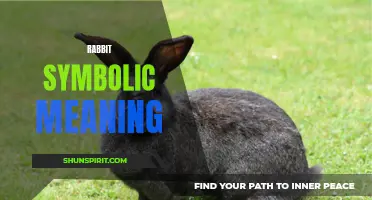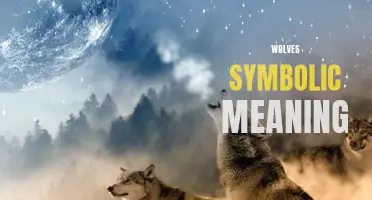
Sukkot, also known as the Feast of Tabernacles, is a Jewish holiday that commemorates the forty years of wandering in the desert after the Exodus from Egypt. During this time, the Israelites lived in temporary dwellings called sukkot, or tabernacles. As part of the celebration, various symbols are used to represent the significance of this holiday. From the sukkah itself, symbolizing the fragility of life and the reliance on God, to the four species - the etrog, lulav, hadass, and aravah - symbolizing unity and diversity, each symbol carries a deep meaning that enhances the experience of Sukkot. So, join me as we delve into the fascinating world of Sukkot symbols and explore their rich significance.
What You'll Learn
- What is the significance of the sukkah as a symbol in Sukkot?
- What do the four species (etrog, lulav, hadass, and aravah) represent in Sukkot?
- How does the symbol of the harvest connect to the celebration of Sukkot?
- What is the meaning behind the practice of waving the four species during Sukkot prayers?
- In what ways do the symbols of Sukkot help to create a sense of community and gratitude?

What is the significance of the sukkah as a symbol in Sukkot?
Sukkot is a Jewish holiday that is celebrated in the fall, usually in September or October. It is a time of harvest and thanksgiving, and one of the central symbols of Sukkot is the sukkah.
A sukkah is a temporary dwelling that is built to commemorate the temporary huts that the Israelites lived in during the forty years they wandered in the desert after leaving Egypt. The sukkah is typically made out of materials such as wooden beams and a thatched roof, and it is usually decorated with branches, fruits, and other symbols of the harvest.
The sukkah is an important symbol in Sukkot for a number of reasons. First, it serves as a reminder of the impermanence of life. The Israelites lived in temporary huts while they were in the desert, and the sukkah serves as a reminder that life is fleeting and that we should not become too attached to material possessions.
Second, the sukkah is also a symbol of unity and community. The Israelites all lived in sukkot together during their time in the desert, and the sukkah serves as a reminder that we are all part of a larger community and that we should come together to celebrate and give thanks.
Third, the sukkah is a symbol of trust in God. When the Israelites were in the desert, they had to rely on God for their sustenance and protection. Similarly, when we sit in the sukkah, we are putting our trust in God and recognizing that everything we have comes from Him.
In addition to its symbolic significance, the sukkah also plays a practical role during the celebration of Sukkot. It is customary to eat meals and sleep in the sukkah during the holiday, and many families spend a significant amount of time in it. This helps to create a sense of joy and togetherness, as well as a connection to nature and the harvest.
Overall, the sukkah is a powerful symbol in Sukkot. It reminds us of the impermanence of life, the importance of community, and the need to trust in God. It also provides a practical way for families to come together and celebrate during the holiday. So when you see a sukkah on someone's property during Sukkot, take a moment to think about its deep significance and the lessons it can teach us.
Understanding the Symbolic Meaning of the Succubus
You may want to see also

What do the four species (etrog, lulav, hadass, and aravah) represent in Sukkot?
The holiday of Sukkot, also known as the Festival of Tabernacles, is a harvest festival that marks the end of the agricultural year. One of the central rituals of Sukkot is the waving of the four species, which are the etrog (citron), lulav (palm frond), hadass (myrtle branches), and aravah (willow branches). Each of these species has a symbolic meaning and represents different aspects of the holiday.
The etrog, or citron, is a unique fruit with a pleasant fragrance. It is considered the most important of the four species and is often referred to as the "heart" of the Sukkot observance. The etrog represents the heart, which symbolizes the emotions and intentions of a person. By waving the etrog along with the other three species, we are reminded to incorporate our emotions and intentions into our worship of God.
The lulav, or palm frond, represents the spine of a person. It is used to symbolize the righteousness and uprightness that we should strive for in our lives. The lulav is held together with the other species and waved in all four directions, symbolizing the unity of the Jewish people and our connection to God.
The hadass, or myrtle branches, represent the eyes, which symbolize wisdom and knowledge. The leaves of the hadass are smooth and have a pleasant fragrance, reminding us to seek wisdom and knowledge in all aspects of our lives.
The aravah, or willow branches, represent the lips, which symbolize speech and communication. The aravah is known for its lack of fragrance and is waved together with the other species in order to remind us of the importance of using our words wisely and speaking with kindness and respect.
By waving the four species together, we are reminded of the importance of integrating our emotions, intentions, righteousness, wisdom, and speech into our observance of Sukkot. The waving of the four species also serves as a reminder of the many blessings that we have received from God and a way to express our gratitude for the abundance of the harvest season.
In addition to their symbolic meanings, the four species are also a way to connect with nature and appreciate the beauty of God's creation. Each of the species has its own unique qualities and together they create a beautiful and meaningful display.
Overall, the four species of Sukkot represent different aspects of the holiday and serve as a reminder of our connection to God, our gratitude for the harvest, and our commitment to living a righteous and meaningful life. By waving these species, we are able to physically and spiritually engage with the rituals and traditions of Sukkot and deepen our understanding and appreciation of this special holiday.
Unveiling the Hidden Meaning Behind Slug Symbolism
You may want to see also

How does the symbol of the harvest connect to the celebration of Sukkot?
The symbol of the harvest holds great significance in the celebration of Sukkot, a Jewish holiday that commemorates the time when the Israelites dwelled in temporary shelters during their journey in the wilderness. Also known as the Feast of Tabernacles or the Feast of Ingathering, Sukkot is a time of joy and thanksgiving for the bountiful harvest.
The symbol of the harvest is closely tied to the core themes and rituals of Sukkot. One of the most prominent symbols of Sukkot is the sukkah, a temporary dwelling constructed for the holiday. The sukkah is typically made of branches, wood, or other natural materials, and it is meant to represent the temporary shelters in which the Israelites lived during their journey in the wilderness. By building and living in a sukkah for the duration of the holiday, Jews are reminded of their ancestors' reliance on God during their time in the desert.
The harvest symbol is further emphasized by the Four Species, also known as the lulav and etrog. These consist of a palm branch (lulav), two willow branches, and three myrtle branches that are bound together, as well as a citron fruit (etrog). During Sukkot, Jews wave the Four Species in all directions, symbolizing the unity of God's creation and their gratitude for the harvest.
In addition to these physical symbols, Sukkot also includes rituals and prayers specifically focused on thanksgiving for the harvest. One such ritual is the recitation of Hallel, a collection of psalms praising God's splendor and thanking Him for the abundance of the earth. These prayers and rituals serve as a way to express gratitude for the blessings of the harvest season and to acknowledge God's role as the ultimate provider.
Overall, the symbol of the harvest is deeply woven into the fabric of Sukkot. From the construction of the sukkah, which represents the temporary dwellings of the Israelites, to the waving of the Four Species, which symbolize the unity of creation and gratitude for the harvest, the harvest symbol plays a central role in the celebration and meaning of Sukkot. By connecting the physical symbol of the harvest to the spiritual themes of reliance on God and gratitude, Sukkot serves as a reminder of our connection to nature, our dependence on the earth's bounty, and our responsibility to care for and appreciate the world around us.
Decoding the Meaning Behind Mickey's Beer Cap Symbols
You may want to see also

What is the meaning behind the practice of waving the four species during Sukkot prayers?
The practice of waving the four species during Sukkot prayers is a central and significant ritual of the holiday. The four species, also known as the "arba minim," consist of the following: the etrog (a citron fruit), the lulav (a branch from a date palm tree), the hadassim (branches from a myrtle tree), and the aravot (branches from a willow tree). During the prayers, the four species are waved in specific directions and shaken, resulting in a beautiful and rhythmic motion.
The act of waving the four species holds deep symbolic meanings. Each of the four species represents a different aspect of the Jewish people and their relationship with God. The etrog, which is a fragrant and beautiful fruit, represents the heart. It symbolizes those who possess both knowledge of the Torah and good deeds. The lulav, which is tall and straight, represents the spine and symbolizes those who possess knowledge of the Torah but lack good deeds. The hadassim, with their pleasant fragrance but lack of taste, represent the eyes and symbolize those who possess good deeds but lack knowledge of the Torah. Lastly, the aravot, which have neither taste nor fragrance, represent the lips and symbolize those who possess neither knowledge of the Torah nor good deeds.
The waving of the four species is done in six specific directions: east, south, west, north, up, and down. Each direction represents a specific aspect of God's kingship and sovereignty over the world. The waving of the four species in all directions represents the acknowledging of God's presence in every corner of the universe.
In addition to the waving of the four species, the shaking of the lulav and etrog during the prayers is also significant. The shaking is done to fulfill the commandment of "rejoicing before the Lord" during Sukkot. It is a physical expression of joy and gratitude towards God for the abundance of blessings received. The shaking of the lulav and etrog also represents the shaking off of sins and negative influences, purifying oneself before the Creator.
The practice of waving the four species during Sukkot prayers dates back to biblical times and is mentioned in various Jewish texts. It is a unique and beautiful ritual that not only connects the Jewish people to their traditions but also serves as a reminder of their relationship with God and the importance of both knowledge of the Torah and good deeds. Through the symbolic actions of waving and shaking, the participants are able to express their joy, gratitude, and desire for spiritual growth.
The Symbolic Meaning Behind Flickering Lights and What It Signifies
You may want to see also

In what ways do the symbols of Sukkot help to create a sense of community and gratitude?
Sukkot, also known as the Feast of Tabernacles, is a Jewish holiday that celebrates the harvest season and commemorates the Israelites' 40 years of wandering in the desert after the exodus from Egypt. It is a time of joy, gratitude, and community-building. One of the key aspects of Sukkot is the use of symbols that help to create a sense of community and gratitude among its participants.
The most prominent symbol of Sukkot is the sukkah, a temporary dwelling constructed for the duration of the holiday. The sukkah represents the makeshift huts that the Israelites lived in during their time in the desert. By dwelling in these temporary structures, participants are reminded of the impermanence of material possessions and the importance of gratitude for what they have. The act of building and decorating the sukkah is often a community effort, with friends and family coming together to construct the structure, hang decorations, and prepare for the festive meals that will be held inside.
Another symbol of Sukkot is the lulav and etrog. The lulav is a bundle of four species of plants - a palm branch, willow branches, and myrtle branches - while the etrog is a citron fruit. These symbols are waved in all directions during the holiday's daily prayers, symbolizing the harvest and the bounty of the earth. By waving the lulav and etrog, participants express gratitude for the abundance of food and resources that nature provides. Additionally, the act of waving these symbols together in unison creates a sense of unity and communal celebration.
Sukkot also includes a tradition known as Ushpizin, where participants invite special guests into their sukkah. These guests are traditionally believed to be the spirits of revered biblical figures such as Abraham, Isaac, Jacob, and Moses. By inviting these guests, participants are reminded of the importance of hospitality and community. This tradition encourages participants to open their homes and hearts to others, fostering a sense of unity and connection among individuals.
Finally, Sukkot is a time for joy and celebration, symbolized by the Four Species Parade. Throughout the holiday, parades are held in many communities, where participants march through the streets while carrying the lulav and etrog. These parades are accompanied by music, singing, and dancing, creating a festive atmosphere that allows people to come together and celebrate. The parade serves as a reminder of the importance of joy and gratitude in building a sense of community.
In conclusion, the symbols of Sukkot play a crucial role in creating a sense of community and gratitude among its participants. From the construction of the sukkah to the waving of the lulav and etrog, these symbols remind individuals of the impermanence of material possessions, the abundance of nature, and the importance of hospitality and unity. By coming together to celebrate and express gratitude, Sukkot fosters a sense of community, joy, and appreciation for the blessings in our lives.
Decoding Caterpillar Warning Symbols: What Do They Mean and How to Respond
You may want to see also
Frequently asked questions
The sukkah symbolizes the temporary dwellings that the Israelites used during their 40-year journey in the desert after the exodus from Egypt. It serves as a reminder of the impermanence of physical possessions and the importance of relying on faith and trust in God.
The four species, or arba’at ha-minim, consist of the etrog (citron), lulav (palm branch), hadassim (myrtle branches), and aravot (willow branches). Together, they represent unity and the different types of people who make up the Jewish community. Each species has its own significance, with the etrog symbolizing the heart, the lulav representing the spine, the hadassim representing the eyes, and the aravot symbolizing the lips.
The etrog is considered a special symbol in Sukkot because of its unique qualities and associations. It is known for its beautiful fragrance and pleasant taste. The etrog also represents integrity and wholesomeness, as it is the only species that has both a pleasant taste and fragrance.
The waving of the four species during Sukkot symbolizes the agricultural aspect of the holiday. It is a way to acknowledge and show gratitude for the abundance of crops and blessings that have been provided by God. The waving motion is also seen as a sign of prayer and supplication, asking for blessings and protection in the coming year.
The sukkah decorations hold symbolic meaning in Sukkot. They are used to beautify the sukkah and create a festive atmosphere. Common decorations include hanging fruits, vegetables, and artwork. These decorations represent the harvest and the blessings of abundance. They also serve as a reminder to appreciate the natural world and the gifts that come from nature.







